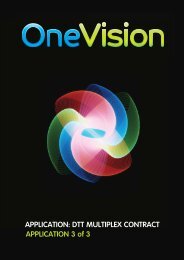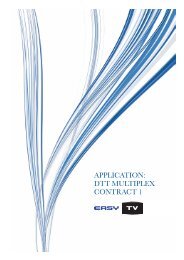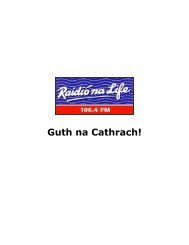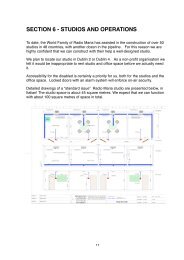Digital Radio for Ireland: Competing Options, Public Expectations - BCI
Digital Radio for Ireland: Competing Options, Public Expectations - BCI
Digital Radio for Ireland: Competing Options, Public Expectations - BCI
Create successful ePaper yourself
Turn your PDF publications into a flip-book with our unique Google optimized e-Paper software.
services such as text and other data, conditional access, enhanced traffic services and picture <br />
transmission. <br />
IBI – (Independent Broadcasters of <strong>Ireland</strong>) represents national, regional and local commercial radio <br />
stations throughout <strong>Ireland</strong>. <br />
<br />
IBOC ‐ (In‐Band, On Channel) or HD – radio ‐ uses the so‐called sidebands on both sides of the <br />
analogue signal <strong>for</strong> the digital signal. This makes it possible to broadcast simultaneously a standard <br />
analogue signal, plus one near‐CD‐quality digital signal and a small amount of additional data. HD‐<br />
<strong>Radio</strong> was developed by iBiquity Corporation in the United States. <br />
<br />
Internet radio ‐ (also known as web radio, net radio, streaming radio and e‐radio) is an audio <br />
transmission service via the internet. <br />
<br />
JNLR ‐ (Joint National Listenership Research). The objective of the Joint National Listenership Research <br />
(JNLR) survey is to provide reliable estimates of audience to National, Regional and Local <strong>Radio</strong>, as a <br />
basis <strong>for</strong> the planning of advertising schedules. The research is carried out by TNS/mrbi <strong>for</strong> the JNLR <br />
Committee. <br />
<br />
MPEG Audio Layer II ‐ an audio codec defined by ISO/IEC 11172‐3. It is a dominant encoding standard <br />
<strong>for</strong> audio broadcasting as part of the DAB digital radio and DVB digital television standards, and it is <br />
the core of the better known MP3 standard. <br />
<br />
MPEG 4/ HE‐AAC v2 ‐ High Efficiency AAC (HE‐AAC) is a lossy data compression scheme <strong>for</strong> digital <br />
audio. It is an extension of Low Complexity AAC (AAC LC) optimized <strong>for</strong> low‐bitrate applications such as <br />
streaming audio. <br />
<br />
Multimedia content – content including or involving the use of several media such as audio, video, <br />
text and graphics. <br />
<br />
Multiplex ‐ A multiplex is a block of frequencies containing radio and data services. Using digital <br />
technology, more services can be carried within these blocks than can fit into a similar FM spectrum. <br />
An electronic system which combines programme material and related and other data in a digital <strong>for</strong>m <br />
and the transmission of that material and data so combined by means of wireless telegraphy directly <br />
or indirectly <strong>for</strong> reception by the general public. <br />
<br />
Ofcom – (Office of Communications) is an independent statutory body which regulates the UK’s <br />
broadcasting, telecommunications and wireless communications sectors. <br />
<br />
Podcasting ‐ combines the MP3‐<strong>for</strong>mat with RSS (Really Simple Syndication) feeds. It allows listener <br />
to transfer files to his computer, laptop or mobile player and subscribe to non linear programmes. <br />
<br />
RAJAR – <strong>Radio</strong> Joint Audience Research is the official body in charge of measuring radio audiences in <br />
the UK. It is jointly owned by the BBC and the <strong>Radio</strong>Centre on behalf of the commercial sector. <br />
<br />
Satellite <strong>Radio</strong> ‐ Satellite radio uses the 2.3 GHz S band frequencies. Satellite radio broadcasters <br />
currently include Sirius Satellite <strong>Radio</strong>, XM Satellite <strong>Radio</strong> and WorldSpace. <br />
<br />
SFN –( Single Frequency Network) is a network of DAB transmitters sharing the same radio frequency <br />
to achieve large area coverage. <br />
<br />
TSA – (Total Survey Area) is the metro survey area, plus all the counties surrounding it, that contribute <br />
a specified proportion of their listening to radio stations within that market. <br />
92






